The Art of Surf Photography: Capturing Waves
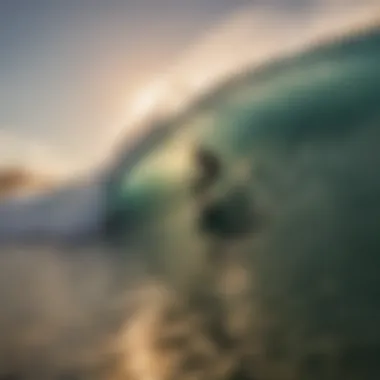
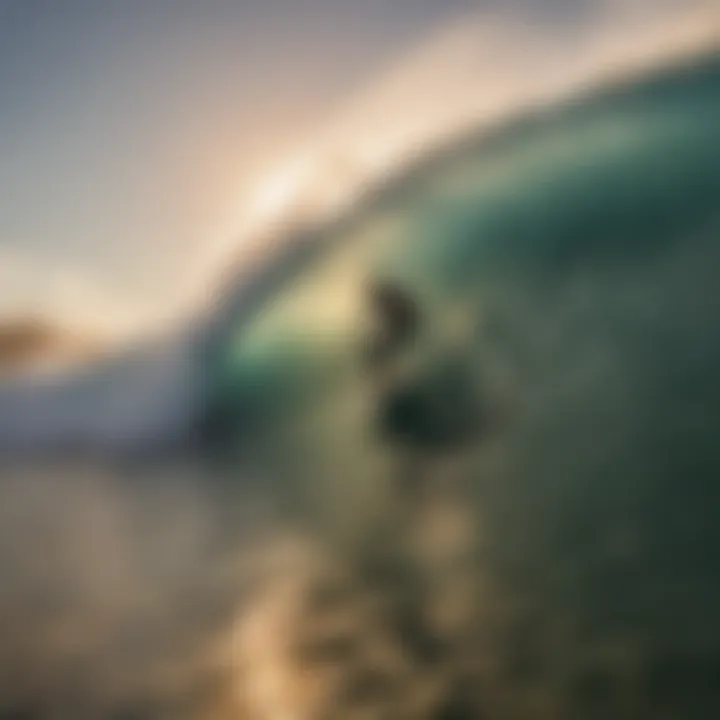
Intro
Surf photography stands as a bridge between two exhilarating passions: capturing the essence of surfing and preserving the raw beauty of nature. This art form doesn’t merely focus on moments; it encapsulates the euphoria experienced by surfers as they dance with the waves. As one positions their lens toward the horizon, what unfolds is a fleeting glimpse into the rhythm of ocean and surfer, a unison that resonates deeply within surf culture.
Engaging in this niche not only demands a keen artistic eye but also an intuitive understanding of surfing dynamics. Each wave varies—some crest dramatically, while others roll softly; being aware of these variances allows for the precise capture of that split-second thrill. This exploration invites readers into the vibrant world of surf photography, highlighting significant techniques as well as the evolution of this craft throughout the decades.
To navigate through this expansive field, one must first equip themselves accordingly. As we embark on this journey together, we will delve into essential gear, tips for both amateurs and seasoned photographers, and underscore notable figures and images that have helped shape this expressive domain.
Prologue to Surf Photography
In the dynamic world of watersports, surf photography holds a unique place, allowing enthusiasts to capture not just the action but the very spirit of surfing. This section is vital because it sets the stage for understanding how photography interacts with the surf culture and lifestyle. For surfers, paddleboarders, and kitesurfers alike, capturing the essence of a ride, the splash of water, or the curl of a wave can be a rewarding pursuit.
This niche of photography involves much more than merely pointing a camera at the ocean. It's about identifying the right moment when a surfer rides the wave flawlessly, embodying both power and grace. The importance of surf photography lies in its ability to showcase thrilling tales, connect communities, and inspire new participants in the sport. Diverse techniques, specific equipment needs, and a keen sense of timing all contribute to a captivating image. This introduction serves as an invitation to appreciate the art behind the lens, detailing its relevance to not only surfers but also to those who revel in the surf culture.
Definition and Overview
Surf photography can be defined as the art of capturing the action and beauty of surfing through the lens of a camera. It combines technical skills in photography with an intimate understanding of water dynamics, wave patterns, and surfing maneuvers.
As a specialized form of outdoor photography, it does not just involve technical proficiency but also requires an awareness of ocean conditions, light changes, and a surfer’s style. Photographers often find themselves in challenging environments, requiring adaptability and a detailed knowledge of their subjects. From photographing professional competitions to capturing spontaneous sessions with friends, surf photography offers a diverse range of experiences and avenues for artistic expression.
The Appeal of Surf Photography
The allure of surf photography goes beyond capturing action shots. For many, it's deeply entwined with the culture and lifestyle that comes with surfing. There’s an intimate relationship between the ocean and the surfers that photographers strive to document. Whether it's a close-up of a surfer carving through a wave or an aerial shot revealing the sheer vastness of the sea, each image carries a story that resonates.
- Connection to Nature: Photographers often find themselves in breathtaking locations, surrounded by the raw beauty of nature. This immersion not only enriches their work but also instills a profound appreciation for the environment.
- Cultural Significance: Surf photography plays a key role in documenting surf culture. It reflects trends, showcases rising talent, and contributes to the narrative of surfing as a lifestyle, beyond just a sport.
- Inspiration and Motivation: Iconic surf images not only motivate surfers but also potential surfers. A well-captured shot can inspire someone to pick up a board for the first time.
"Each photo tells a story. Capturing that essence is an art form in itself; it's not just an image, it’s a moment frozen in time, a shared experience of thrill and passion."
For many, it serves as a bridge between their love for photography and the ocean. The conversation sparked through these images fosters community, encourages environmental awareness, and pushes the boundaries of creativity. Capturing the essence of surfing is, above all, about merging passion with artistic expression.
Historical Context
Understanding the historical context of surf photography enriches our insight into its evolution and significance within the surf culture. This art form didn't just emerge out of thin air; it has roots that intertwine with the development of both surf culture and photographic technology. By examining its origins and milestones, one can appreciate how far we have come and where the craft might be headed. This background serves not only as a testament to the passion of those involved but also highlights the changing perceptions of surfing as a sport and lifestyle.
Origins of Surf Photography
The origins of surf photography trace back to the mid-20th century, coinciding with the rise of surfing as a leisure activity. Early surf photographers utilized basic cameras, which performed poorly in the rugged, salt-kissed environment. One of the first to capture the surfing culture on film was the American photographer, Frosty Hesson, who documented the surf scene in California during the 1960s. The shots taken back then, albeit grainy, conveyed the raw, untamed spirit of the ocean.
As surf culture grew, so did the need for better equipment. Photographers had to adapt their techniques to capture surfers in motion, often resulting in images that were as much about the ocean as they were about the sport itself. The emergence of waterproof cameras, such as the Nikon F, allowed photographers to venture closer to the action, capturing waves breaking over the surfers with breathtaking clarity.
It's fascinating to note how these early images didn’t just serve as records of the sport; they became artifacts of a lifestyle that many aspired to embrace. Through these lenses, surfing transitioned from a niche hobby to a full-blown cultural phenomenon.
Key Milestones in the Discipline
Several milestones have significantly shaped surf photography into what it is today.
- 1970s-1980s: The introduction of larger, more specialized lenses made it possible to capture the subtleties of surfing, like the nuances of a surfer’s technique or the perfection of a wave’s curl. It was during this period that photographers like Jeff Divine and Larry “Flame” Moore rose to prominence, providing a window into the lifestyle surrounding the sport.
- 1990s: This era saw the advent of digital photography, fundamentally altering the approach to surf photography. With digital cameras, instant feedback allowed photographers to refine their techniques on the fly, resulting in higher-quality images and new possibilities for creative expression.
- 2000s onwards: The integration of drone technology has completely transformed the landscape of surf photography, enabling aerial shots that were once impossible. Drones provide unique perspectives of surfers tackling daunting waves in ways that ground-based photographers simply couldn’t achieve.
"Surf photography is more than just capturing a wave. It's about freezing a moment in time that tells countless stories of adventure, struggle, and triumph."
Today, whether encapsulating a serene dawn paddle out or the chaos of a massive swell, surf photography stands as a vital vertical of the overall surfing experience, reflecting the culture and the evolution of both the sport and the art. Understanding these key milestones offers not just historical knowledge but inspires aspiring photographers to find their unique place in this ever-evolving discipline.
Essential Equipment
When it comes to surf photography, having the right equipment can make or break your shots. The waves are often unpredictable, and the conditions can shift in an instant. Thus, essential gear not only helps in capturing those breathtaking moments but also ensures safety and durability while you’re out there battling the elements. As the old saying goes, "The right tool for the job," holds particularly true in this art form.
Cameras and Lenses
In the world of surf photography, the camera and lens are perhaps the most crucial pieces of equipment. A high-quality camera can capture high-speed action and maintain clarity in challenging light conditions.
Generally, DSLRs or mirrorless cameras are favored for their adaptability and superior image quality. These types allow for interchangeable lenses, giving photographers the flexibility to adjust according to the specific conditions. Wide-angle lenses can beautifully capture the swell and landscape, while telephoto lenses are great for getting close-ups from a distance, especially when surfers are riding those massive waves.
Key considerations include:
- Weather sealing: Essential in the harsh seaside environment.
- Frame rate: A higher frame rate allows for capturing rapid movements.
- Sensor size: Larger sensors provide better performance in low light.
The choice of lens often boils down to personal style and the environments you favor. Whether you’re capturing the serene beauty of morning waves or the intensity of a midday surf competition, having the right lens makes all the difference.
Accessories for the Perfect Shot
Accessories play a pivotal role in enhancing your photography experience. They provide the necessary support and adaptability in the often challenging surf conditions.
Waterproof Housings
Protecting your equipment is paramount when shooting in the ocean. Waterproof housings not only safeguard your camera from water but also let you submerge your gear for some stunning underwater shots. A housing can be a lifesaver, literally, preventing water damage — an often costly affair.
One of the standout features of these housings is their depth rating; many can withstand considerable immersion at various depths. This gives photographers the unique ability to capture surfers riding waves from below. However, not all housings have the same level of durability. Some cheaper options can be more susceptible to leaks or may restrict camera functions, which can be detrimental when timing is everything.
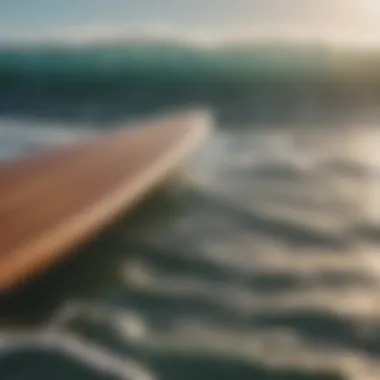
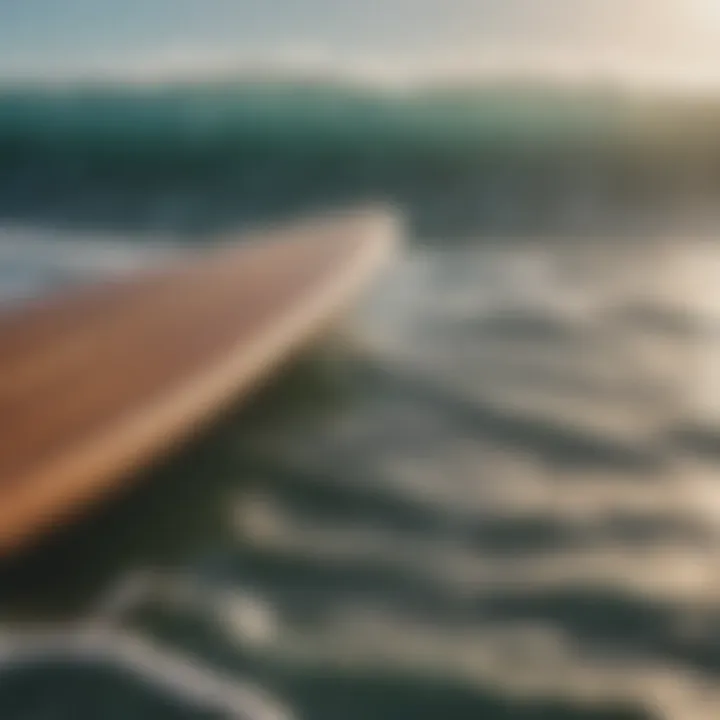
Benefits of quality waterproof housings include:
- Durability: Designed for harsh marine conditions.
- Functionality: Maintains access to camera controls.
- Flexibility: Compatibility with various camera models.
Despite their importance, they can be bulky and inconvenient for some users, making it worth considering the environment you generally shoot in.
Tripods and Stabilizers
Stability is key in capturing sharp images, particularly in dynamic environments like surf zones. Tripods and stabilizers help manage shaky hands from ocean spray or shifting sands. This gear is especially beneficial for long exposure shots, allowing you to blur the motion of waves while keeping the surfer in focus.
A reliable tripod should be lightweight yet sturdy, as windy conditions can easily knock over flimsy models. One unique feature of many modern tripods is their adjustable legs, capable of setting up on uneven or sandy surfaces. Having the ability to quickly stabilize your setup can lead to remarkable shots that convey the movement and power of ocean waves.
Although this gear offers significant advantages, some photographers might find that the bulk of a tripod can slow down their mobility when chasing the perfect shot.
Remote Triggers
Remote triggers are essential for those moments when timing is everything—capturing split-second actions without the risk of camera shake. By allowing you to shoot from a distance, these triggers enable photographers to get the shots they might not be able to if they're too close to the action.
Many remote triggers now come with wireless capabilities, making them convenient and easy to use while you're positioned in tricky spots. Interestingly, they also serve well in high-pressure conditions, like big wave shooting, where you need to maintain a safe distance from the surf.
Despite their advantages, remote triggers can sometimes introduce connectivity issues or be less responsive in certain weather conditions, so it's worth doing your homework before opting to rely solely on this gear.
The right equipment not only makes your shooting experience smoother but also enhances the quality of your photographs, allowing you to truly capture the essence of surfing.
In summary, investing in quality cameras, lenses, and a selection of dependable accessories will set the stage for success in surf photography. The ocean never sleeps, and neither can your camera gear.
Techniques for Capturing Waves
When it comes to surf photography, mastering the techniques for capturing waves is absolutely vital. This art form isn't just about pressing a button at the right moment; it revolves around timing, angles, light, and the proper post-processing steps that elevate a simple photograph into a captivating work of art. Each of these elements plays a crucial role in conveying the raw energy and beauty of a surfing moment. Whether you're aiming to showcase the tumultuous rush of the waves or the serene triumph of a surfer catching the crest, understanding these techniques can make all the difference in your final image.
Timing and Angles
They say timing is everything, and in surf photography, this saying rings true time and again. Capturing a wave at its peak is like catching lightning in a bottle. If you miss it, the opportunity is gone. The rise and fall of water creates shapes full of movement—that perfect wall of water just before a surfer drops in, or the moment of impact when a surfer lands a trick.
Choosing the right angle also enhances your shots. From the shore, you might get a wide view. But sometimes, a low angle from inside the water could give an exhilarating perspective, making the surfer look like they're riding a giant beast. Getting your feet wet—literally—can help you find those angles that grab attention.
"Angles and timing are the brushes, and the ocean is your canvas."
For beginners, experimenting with various positions during different parts of the surf can develop your eye for potential shots. Try shooting from the water’s surface level, or even tackling higher ground like cliffs to gain a broader perspective of the action that unfolds below. Each angle can tell a different story, whether it's the sheer force of a wave crashing down or the elegance of a surfer gliding effortlessly.
Understanding Light and Conditions
Light is the heart and soul of any photography, more so in surf photography where the changing conditions can drastically impact your shots. Early mornings or late afternoons, known as 'golden hours', provide a warm, soft light that's perfect for enhancing the colors of both the ocean and the surfers. Midday sun, on the other hand, might cast harsh shadows and wash out colors.
Moreover, understanding the weather complements the whole experience. Sunny days may seem picturesque, but overcast conditions can yield dramatic shots with moody atmospheres. Pay attention to how waves behave under different weather conditions; choppy waters may suggest a stormy backdrop, while a calm sea can create a tranquil scene.
A practical tip for rookie surf photographers is to keep an eye on the forecast and tides. Check surf reports for wave height and periods, which can inform you about the best times to shoot. Also, learning to read the ocean itself, knowing where waves will break, is a skill that can significantly enhance your ability to be in the right place at the right time.
Post-Processing Techniques
Once you've successfully captured those incredible shots, the next step is post-processing, where the magic can continue on screen. Editing isn’t just about making things look nice; it's about respecting the essence of the image while enhancing its appeal. There are several techniques to explore here.
- Color Correction: Adjusting hues and contrast can really bring your images to life. Tweaking certain colors can dramatically impact the mood—crisp blue skies, vibrant ocean blues, or the rich tones of a sunset can all be reinforced in the edit.
- Cropping for Composition: Sometimes, a simple crop can enhance the focus on the surfer or wave. It’s all about framing your subject correctly in the environment they are in.
- Sharpening: This detail-oriented technique will help enhance the clarity of your images, especially important when showcasing the action of surfing.
- Filters and Effects: Apply selective filters to change the atmosphere of the image, but make sure not to overdo it. Less is often more in achieving that natural look.
A great tool for post-processing is Adobe Lightroom, which allows photographers to manipulate images with great flexibility. For an easy start, focus on mastering the basics before diving into more advanced techniques.
By integrating these post-processing techniques with the well-captured images, you can elevate your surf photography to a new level that resonates deeply with viewers.
Challenges in Surf Photography
Surf photography, while an exhilarating endeavor, brings with it a unique set of challenges that can test both the skill of the photographer and the capabilities of their equipment. Understanding these challenges is crucial for anyone looking to capture the essence of the waves. It isn't just about pointing a camera at a surfer and clicking the button; it's about navigating a myriad of environmental factors, ensuring safety, and remaining adaptable to changing conditions.
Environmental Factors
The environment plays a pivotal role in surf photography. Factors such as tide, wave size, wind conditions, and even weather can significantly affect the quality and dynamics of the photos. Here are some key elements to consider:
- Tides and Currents: Knowing how tides affect wave conditions is crucial. Low tide can expose rocks or shallow reefs, impacting where to shoot from and when.
- Light Conditions: Shooting at dawn or dusk can yield golden hour lighting, yet the changing light can challenge exposure settings, requiring quick adjustments.
- Weather Changes: Sudden changes in weather can surprise any photographer. Storms can create dramatic scenes but also pose safety hazards.
Being aware of these conditions not only helps in capturing stunning images but also informs decisions on positioning and timing.
Safety Considerations
Safety is non-negotiable in surf photography. The ocean, while beautiful, can be unpredictable. Here are some safety tips to keep in mind:
- Know Your Limits: Whether you're swimming out or standing on a rocky outcrop, understanding your own abilities is paramount. Swimming in large surf requires confidence and skill.
- Gear Safety: Using equipment like water housings protects your gear, but they can't ensure your safety. Regular checks and familiarity with your gear can prevent accidents.
- Lifeguard Awareness: Always be aware of lifeguard stations and their advice. Local surf conditions vary greatly, so respect their knowledge.
"Surf photography not only captures a moment, it often tests your limits. Respect the ocean and its power."
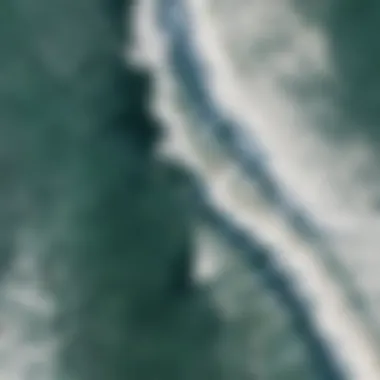
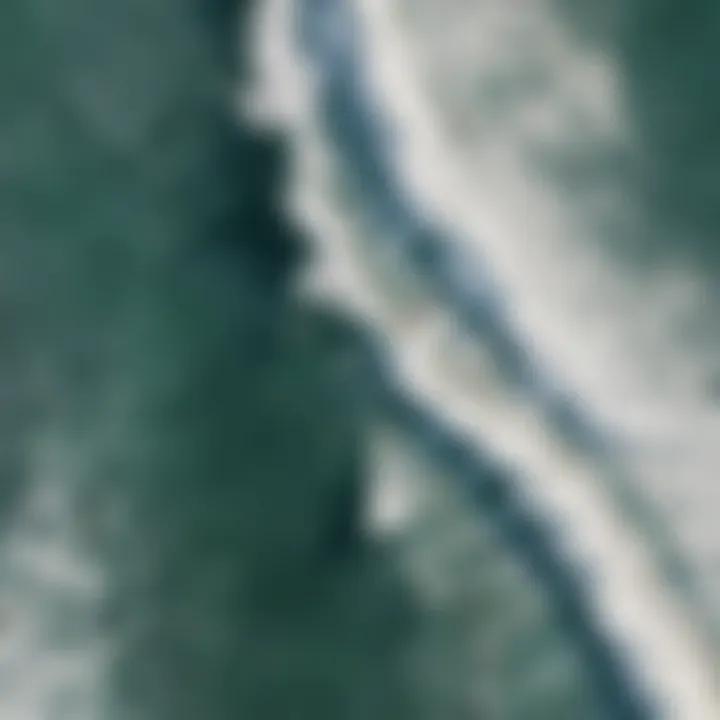
By acknowledging these challenges and implementing strategies to mitigate them, photographers can create compelling imagery while ensuring their own safety and that of their subjects. Essentially, the art of surf photography is not just about capturing the waves but also mastering the environment and respecting the inherent risks of ocean life.
The Role of Surf Photography in Watersports Culture
Surf photography is not merely a niche area of photography; it acts as a vivid tapestry weaving together the very essence of the surf culture. This craft does more than freeze moments in time; it encapsulates the thrill, the community, and the lifestyle that characterize surfing. Through the lens of a camera, photographers capture not just waves, but the spirit and camaraderie shared amongst surfers and enthusiasts.
Portraying the Surfing Lifestyle
When you think about surf photography, the first images that might come to mind often showcase surfers carving through pristine waves at dawn, with the sun peeking over the horizon. This portrayal goes beyond beautiful imagery; it exemplifies a lifestyle rooted in freedom and adventure. Photographers who specialize in this field often immerse themselves in surf culture. They understand that every shoot reflects the deep connection surfers hold not just with their boards, but also with nature and their local communities.
Here are several elements that contribute to how surf photography illustrates this lifestyle:
- Intimate Moments: Photographers often capture the quiet moments before the ride, showcasing surfers' focus and anticipation. This candid portrayal creates a narrative of passion and respect for the ocean.
- Community Events: Surf competitions and festivals offer rich opportunities to document the spirit of surf culture—community support, the excitement of competition, and the friendships forged.
- Travel and Adventure: Many shoots take place in breathtaking locations—from remote beaches to iconic surf spots. Each picture tells a story of exploration and the desire to embrace diverse cultures.
Through these images, photographers play a vital role in portraying surfing as a way of life. The moment a viewer sees a picture of a surfer in action, they aren’t just looking at a wave; they are catching a glimpse of a vibrant lifestyle, filled with passion, dedication, and connection to the environment.
Influence on Surf Brands and Marketing
Surf photography also serves as a powerful tool in the marketing strategies of surf brands. The imagery speaks volumes, often reaching audiences far beyond the confines of surf culture.
- Brand Identity: Companies use striking images in advertising campaigns, visually communicating their brand ethos. A powerful surf image not only showcases a product but also evokes the lifestyle associated with it. This is invaluable in a market where emotions often dictate consumer behavior.
- Social Media Presence: In today's digital age, surf photography finds its way to social media platforms where brands engage with their audiences. Instagram, for instance, is flooded with visually captivating content that resonates with followers, fostering brand loyalty and community.
- Collaborations with Influencers: Surf photographers often collaborate with surf influencers to enhance brand awareness. The shared images of these influencers riding their boards help cultivate a relatable, aspirational image that appeals to potential customers.
The visual narrative created by surf photography enables brands to connect with consumers in a way that words alone cannot accomplish. It's an art form that both tells stories and sells products.
The connection between surf photography and branding doesn’t end with aesthetics; it helps build an emotional bridge between brands and consumers that anchors the market in reality.
Notable Surf Photographers
In the tapestry of surf photography, certain individuals have left an indelible mark on the art form. Their work has not only shaped how surfing is visually documented but has also influenced the culture surrounding the sport itself. By studying the lives and contributions of these notable surf photographers, we can glean insights into their techniques, perspectives, and the passionate pursuit of capturing the essence of surfing.
Profiles of Pioneers
The history of surf photography is heaped with names that stand as paragons of skill and creativity. One cannot discuss this topic without reflecting on the likes of Aaron Chang, who has become synonymous with surf art galleries. Chang’s work is characterized by breathtaking images that meld the rawness of the ocean with the grace of the surfer, showcasing a harmony that is beyond mere sports photography. His journey began in the 1970s, and since then, he has gone on to redefine how surf photographers approach their craft.
Another notable figure is Jeff Divine, who played a crucial role in portraying the emerging surf culture during the 1970s in California. Divine's photographs were not just about the waves; they captured the spirit of a generation. Living through that era, he offered a perspective that resonated deeply with surfers and non-surfers alike. The candidness and honesty in his works make them timeless, proving that the essence of surf photography lies not just in the action of riding ondas but in the entire lifestyle.
Modern Innovators in Surf Photography
As we glance into contemporary times, innovative photographers continue to push the boundaries of surf photography. Chris Burkard stands out as a modern artist combined with the modern age tools. Famous for his vibrant images that often feature rugged landscapes, he presents surf photography not just as a snapshot of a sport but as a broader commentary on nature's beauty and fragility. His ability to incorporate adventure elements into surfing has made his work resonate with a diverse audience. By sharing his stories online, he has amassed a following that eagerly anticipates his next breathtaking shot.
In a different vein, Zach Noyle has carved a niche through his use of technology, particularly drones and underwater housing. Noyle’s unique perspective caught on film from above and below the waves has redefined how surfing can be captured. His bold imagery captivates not just surfers but also those who appreciate dynamic and challenging perspectives, furthering the narrative of what surf photography can convey.
"Photography is more than just taking pictures; it's about capturing moments that tell a story about the essence of life on the waves." – an underlying philosophy that is echoed by many of these experts.
These notable surf photographers, both past and present, illuminate the zeitgeist of surfing through their lens. Their contributions provide not only visual delights but also forge connections between the ocean, the sport, and the culture surrounding it, inviting future generations to follow their lead.
Iconic Surf Images
Iconic surf images stand as a visual testament to the spirit of the ocean and the surfers who navigate its ever-changing waves. These photographs not only showcase the breathtaking beauty of surfing but also capture moments of triumph, struggle, and harmony between man and nature. The importance of these images extends beyond aesthetic value; they serve as cultural markers, preserving the essence of surf culture in a way that resonates deeply with enthusiasts and casual observers alike.
The dynamic nature of surf photography allows a photographer to create a story - each shot a chapter that contributes to a larger narrative about surfing. Iconic images resonate because they evoke emotion and spark inspiration. Whether it’s a breathtaking aerial photograph of a surfer slicing through a turquoise barrel or a candid shot of a local surf competition, these images encapsulate the passion and dedication that define surfing.
Analysis of Influential Photographs
Delving into influential photographs unveils the artistry behind capturing the waves. Consider the iconic image of Kelly Slater at the Pipe Masters; the framing, timing, and the sheer intensity of the moment showcase not just the skill of the surfer, but also the volatility of the ocean itself. Such photographs become etched in memory, setting standards for what surf photography can achieve.
Here are several key takeaways from analyzing these powerful shots:
- Composition: The rule of thirds, leading lines, and using the horizon thoughtfully can turn a simple photograph into an art piece.
- Emotion: The best surf photos resonate emotionally. They capture not just the act of surfing, but the essence of freedom, exhilaration, and community.
- Context: Location plays a big role. An image taken in the dramatic backdrop of Hawaii carries different weight than one taken in a beach break off Southern California.
"A great photograph is a story, not just a snapshot. It's about that split second when light, movement, and passion collide."
Impact on Public Perception of Surfing
The impact of iconic surf images goes far beyond the realms of photography; they influence public perception of surfing as an art form and a lifestyle. In the age of social media, these images become the face of modern surf culture, shaping how the world views the sport. A sizzling shot of beachgoers cheering for a local hero can inspire young athletes to take up surfing, while breathtaking imagery can highlight the importance of ocean conservation.
Moreover, brands leverage these powerful visuals to connect with the surfing community and create emotional ties with consumers. This can often shift the narrative around surfing from a mere sport to a lifestyle choice, embodying adventure, freedom, and respect for nature.
Without a doubt, iconic surf images are not just photographs. They are the heartbeat of the surf culture, pulsing with stories, emotions, and aspirations. As they circulate through galleries, magazines, and digital platforms, they continue to educate a new generation about the waves, the surfers, and the enduring allure of the ocean.
Surf Photography in the Digital Age
The digital age has turned the world upside down, especially in fields like surf photography. The quick turn of technology has not only changed how photographers operate, but also how their work is shared and appreciated. Traditionally, photography demanded a fair bit of investment in time and resources, but digital platforms have streamlined and democratized this art. With the right equipment, anyone can snap stunning shots of surfers carving through waves, igniting a passion that extends beyond the shoreline.
One major benefit of this shift is access to a vast online community. Social media has given voice and visibility to countless aspiring photographers. They now have a platform to showcase their work to a global audience, providing not only feedback and encouragement, but also opportunities for collaboration and exposure. Surf photography, once confined to niche audiences, can now go viral within moments, attracting sponsorships and gaining followers like never before.
But, let’s not kid ourselves. Jumping on the digital bandwagon comes with its own set of challenges. The sheer volume of images shared daily can drown out more nuanced works. Thus, finding a manner to distinguish oneself has become key. The magic often lies in capturing that fleeting moment—the split second when a surfer masters a trick, or the raw power of an apex wave crashing down. Striking that balance is an ongoing game of artistry in a fast-paced digital environment, where trends can shift faster than the tides.
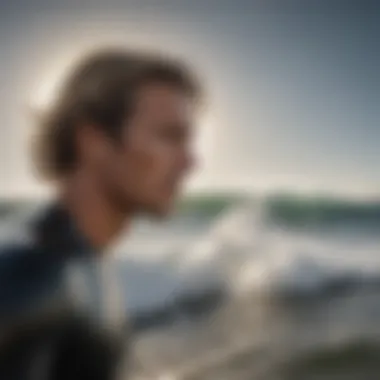
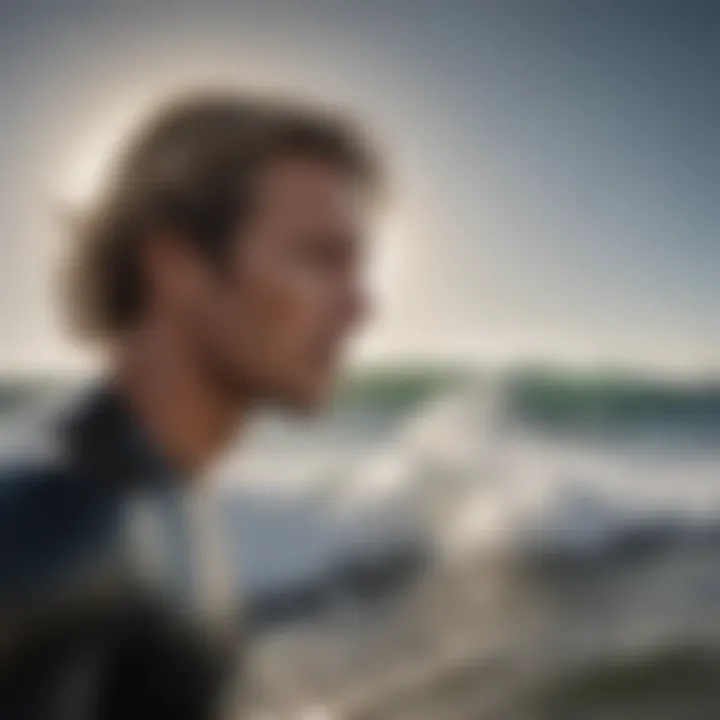
"In surf photography, the most compelling images often tell a story, a glimpse into a world defined by waves and the people who ride them."
Social Media's Influence
The impact of social media on surf photography has been nothing short of revolutionary. Platforms such as Instagram and Facebook have transformed how photographers disseminate their work. Where once photo magazines and localized exhibitions held sway, now an Instagram post can reach thousands within moments. This immediacy fosters connection. Photographers can not only share their images, they can also interact with surfers and fellow photographers directly through comments and messages.
- Hashtags play a crucial role; they work like breadcrumbs, leading viewers to a treasure trove of content.
- The sense of community is palpable. Through shared experiences and active engagement, both surfers and photographers build a camaraderie that transcends geographical boundaries.
Equally noteworthy is the significant role of influencers. Many surfers with substantial social media followings fuse their passion for riding waves with a flair for photography. Their posts, often featuring their own rides alongside dramatic backgrounds, have encouraged other enthusiasts to pick up a camera. As a result, a collaborative atmosphere has formed, where surf culture gets amplified.
However, it’s essential to maintain authenticity amid this landscape. Many seasoned photographers are adamant about staying true to their style, focusing on storytelling rather than trends. Feeling the pressure to curate a pleasing feed can sometimes sideline the essence of true art.
Emerging Technologies
Emerging technologies are doing wonders in how surf photography is approached today. The introduction of drone technology, for example, revolutionizes the perspective from which we view the waves and riders. Drones can capture sweeping aerial shots that ground-level photography simply cannot achieve. As these devices become more accessible, they redefine the boundaries of what’s possible in capturing the ocean’s thrill.
- 360-degree cameras offer another layer of immersion. By capturing the environment from all angles, they allow viewers to feel the rush as if they were there, riding the wave alongside the surfers.
Furthermore, advances in camera sensors and image stabilization mean that photographers can now shoot in conditions that would have historically been deemed challenging. Stormy weather or rapid movements do not need to be a hurdle any longer. High-performance cameras can deliver crisp shots even in low light or rugged conditions. This adaptability adds yet another dimension to the artistry at play.
Overall, the age of digital media—with advancements in technology and social media—has brought forth a renaissance period for surf photography. It invites not just professionals but allows everyone to dip their toes into this exhilarating blend of art and adventure. The lure of the ocean, now more than ever, is captured and spread across the world, igniting the passion of future generations of surf photographers.
Tips for Aspiring Surf Photographers
Embarking on the journey of surf photography can feel like riding a wave; it’s exhilarating, but can also be intimidating at times. This segment sheds light on the critical aspects that every budding surf photographer should consider to thrive in this captivating discipline. From building a portfolio that speaks volumes about your vision to establishing solid ties with fellow photographers and surfers, there’s much to unwrap.
Building Your Portfolio
One of the pillars of a successful surf photography career is having a robust portfolio. This collection isn't merely a showcase of your work, but a visual narrative that reflects your unique perspective and style. Here are a few salient points to consider:
- Diversity in Shots: Include a variety of shots that range from wide-angle views capturing the whole beach during a sunset to close-ups that might show the intricate details of a surfer's expression as they conquer a wave. This demonstrates your versatility and ability to approach surf photography from different angles.
- Consistency in Quality: A weak photo can undermine a remarkable portfolio. Aim to include only your best work. It’s much better to have a smaller collection of outstanding images than a larger, mediocre one.
- Thematic Cohesion: While diversity is key, there should still be a thread that ties your images together—whether it’s your editing style, your subject matter, or how you portray the surfing lifestyle.
- Online Presence: Set up a website or social media profile dedicated to your work. Platforms like Instagram or Flickr allow you to reach a community of enthusiasts and professionals alike. Take the time to engage with feedback and continuously refine your approach.
A portfolio is not just for show; it’s a conversation starter and a potential pathway to opportunities in surf photography.
Networking and Collaborations
Networking plays a vital role in amplifying your reach as a surf photographer. The relationships you cultivate can lead to collaborations that enhance your portfolio and skillset. Here are some practical tips:
- Attend Surfing Events: From local competitions to global tours, these gatherings are hubs of activity. They present opportunities to meet surfers and fellow photographers. Cultivating relationships in person can often lead to long-term partnerships.
- Join Online Communities: Websites like Reddit and specialized Facebook groups dedicated to surf photography can be invaluable. Participate in discussions, seek feedback on your work, and look for collaboration opportunities. Building a rapport online can sometimes lead to real-world connections.
- Collaborate on Projects: Reach out to surfers who are looking for images for their profiles or brands seeking lifestyle shots. Offering your services to help them creates a win-win situation. Not only does it expand your portfolio, but it can also lead to greater exposure through their networks.
- Mentorship: Seek out established photographers whose work you admire. They can provide guidance, insights, and possibly opportunities that come from their experience.
Building a network isn't just about increasing followers, it's about cultivating relationships that foster growth in your craft.
Engaging with the surf community is indispensable. The essence of surf photography isn't just about capturing moments; it's also about forming bonds that inspire and influence creative expression. By nurturing your portfolio and your connections, you set a solid foundation on which to base your surf photography endeavors.
Future Prospects in Surf Photography
As surf photography continues to develop, it holds significant promise for both enthusiasts and professionals in the field. With technology advancing at a breakneck pace, the ways we capture and share surf moments are constantly being revolutionized. Understanding these future prospects allows aspiring photographers to position themselves strategically within the industry and keeps veteran photographers abreast of potential shifts in the landscape.
Trends to Watch
The surf photography community should keep a keen eye on several emerging trends:
- Drones: The use of drones is skyrocketing. They offer unique aerial perspectives that can capture surfers from angles previously thought impossible. As drone technology becomes more accessible, expect an increase in breathtaking shots that highlight not just the surfer, but the vast oceanic context.
- Compact Cameras with High Functionality: With the rise of advanced compact digital cameras, photographers can achieve professional-quality shots without hauling heavy equipment. Brands like Sony and Canon are making waves in this space.
- Film Resurgence: Amid the digital dominance, there seems to be a renewed interest in film photography. Some purists argue that the grain and depth of film images better capture the essence of water and surf culture.
- Virtual Reality and 360-degree Photos: As VR technology evolves, capturing a surfing experience in an immersive format might soon be the norm. It presents a whole new way for audiences to feel the thrill of the waves, stepping into a surfer's shoes via a simple screen.
"In the next few years, photographers who embrace these tools can create works that resonate more deeply with viewers, inviting them to feel present in every flick of water and flip of a board."
Potential Evolution of Techniques
As photographers adapt to new technologies and trends, their techniques will evolve accordingly. Here are several areas likely to witness notable advancement:
- Increased Focus on Post-Processing: The advent of powerful software like Adobe Lightroom and Photoshop has turned the editing suite into a crucial part of the photography process. Photographers may develop unique editing styles that distinctively convey their artistic vision.
- Advanced Autofocus and Burst Modes: Modern cameras are boasting faster autofocus capabilities and high frames-per-second burst modes. This will allow photographers to capture split-second actions on the waves, leading to more dynamic and thrilling compositions.
- Personal Branding: As more photographers enter the field, establishing a unique identity will be increasingly important. Personal branding through social media and collaboration will help individuals stand out. Learning to manage an online persona can amplify a photographer's reach and relevance.
- Emphasis on Sustainability: With growing awareness around environmental issues, there is likely to be a push for eco-friendly practices in surf photography. This includes everything from using sustainable materials for gear to advocating for clean oceans.
Understanding these future directions isn’t just about keeping up; it’s about creating opportunities for innovation and community building. Engaging with these evolutions can spark inspiration, ensuring that the art of surf photography continues to thrive and captivate.
Finale
The art of surf photography is more than just snapping pictures of surfers riding waves. It encapsulates a series of important elements that come together to form a unique narrative of the surfing experience. In this article, we have dived into the historical background of surf photography, explored vital techniques and equipment, and considered the cultural significance that surrounds each captured moment.
The Ongoing Journey of Surf Photography
Surf photography continues to evolve, influenced by advancements in technology and shifts in societal perceptions of surfing. Every photograph tells a story—not just of the sport, but of the moments that happen outside the water, too. From the thrill of catching a wave to the tranquility found in the calm blue, photographers capture multifaceted aspects of a lifestyle that is lived in a constant ebb and flow.
The journey for a surf photographer often feels like riding the perfect wave. You start with the right gear, and as you learn from each shoot—what works and what doesn’t—you refine your craft, much like a surfer who finds their footing on the board. The determination to capture that ideal shot keeps many photographers on their toes, always seeking to push boundaries and discover new perspectives.
Invitation to Explore and Create
As you digest the insights shared throughout this article, it’d be beneficial to remember that the world of surf photography is a vast sea waiting to be explored. Whether you're an aspiring photographer, a seasoned pro, or even a surfer keen to dabble in photography, the opportunities for creativity are endless. Grab your camera, step outside, and immerse yourself in the rhythm of the waves.
Start small—perhaps aim for capturing the energy of a local surf session or pay attention to details often overlooked: the salty spray in the air, the vibrant colors in the sky at sunset, or the intensity of the wave preparing to break.
Remember, every image you create contributes to a greater narrative, weaving your unique perspective into the rich tapestry of surf culture.
"Photography is the story I fail to put into words." – Destin Sparks.
The journey of surf photography is ongoing, and every click can ignite new inspirations for stories waiting to be told. So, don’t hesitate; get out there and let your creativity flow!



